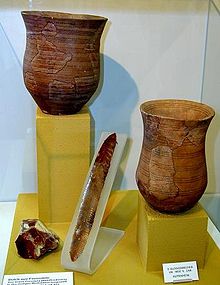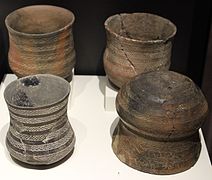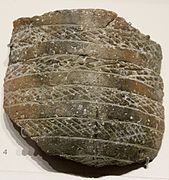Bell Beaker Culture
|
||||
| expansion | ||||
|---|---|---|---|---|
| Distribution map (localities) according to Harrison 1980; Subdivision into eastern group (Hungary to the upper Danube region), western group (Rhine region to Pyrenees, Great Britain) and southern group (Iberian Peninsula, Mediterranean) |
||||
| Leitforms | ||||
|
The bell -beaker culture is an end-Neolithic culture that was found in southern, western and central Europe (in the east as far as Hungary) from 2600 BC. Occurs until about 2200 BC. And only in Great Britain until approx. 1800 BC. Exists. In these regions it represents a culture at the transition from the Neolithic to the Bronze Age .
Research history
Ceramic vessels with a flat base and an S-shaped profile, which are usually decorated over the entire area, are called "bell beakers". In 1900 the prehistorian Paul Reinecke , who was then working in Mainz, used this term, which had been used by Italian and Czech-speaking prehistorians, and introduced it into German terminology.
The classification of the Bell Beaker Culture (GBK) as an independent archaeological culture is controversial. Gordon Childe saw the bell-beaker people as missionaries who, coming from Spain, spread across the Atlantic edge of Europe and brought with them the knowledge of copper metallurgy. Stephen Shennan ( UCL ) , in particular, is of the opinion that the typical bell beaker furnishings are the prestige goods of a new upper class . Christian Strahm (Freiburg) coined the term bell beaker phenomenon in order to avoid the expression culture .
In 1972, Edward Sangmeister identified the bearers of the bell-beaker culture as a mobile society, divided into small groups, valued for their skills in searching for, processing and negotiating coveted materials. The lack of settlement finds supports the early hypothesis of the highly mobile "Beaker People".
The bell-cup culture is not widespread in Europe, but formed island-like concentrations of finds (e.g. southern Bavaria). At least for the early phases one can hardly speak of a "culture" in the narrower sense, since elements such as B. common ceramics, house types or uniform burial customs are missing. The latter, however, applies to the more recent phases of the bell beaker culture. Today, from an archaeological point of view, the model of a social stratification is preferred, according to which the increasing social differentiation in the late Neolithic led to the formation of privileged groups who had and took advantage of the opportunity to trade / exchange prestige goods over greater distances.
distribution
The spread of the bell beaker culture included
- Central Europe (from Hungary via Poland (the Supraśl burial mound as the most easterly point) to Denmark (especially Jutland - Bejsebakken ), Germany and Switzerland, where it interrupts the lakeside settlement phase)
- Western Europe (Netherlands, France, Great Britain, Ireland)
- Southern Europe (Italy with Sicily and Sardinia, the Iberian Peninsula with the Balearic Islands, but not Corsica )
- Morocco
Burial form

Individual burials in earth graves or stone boxes are typical of the ritual of the dead in the continental bell-cup culture . In some cases their former hilltop can be reconstructed. In the western area of distribution, subsequent burials in megalithic complexes and burials in caves often occur - sometimes as multiple burials, also adapted to the previous megalithic traditions . The bell beaker and the individual grave culture show their influences in numerous large stone graves wherever the cultures spatially touch with the spread of the megalithic complex. If you add the shards that were recovered from the disturbed facilities, you have to state that one of the two cultures, mostly both, is represented in at least half of all large stone graves. In western Switzerland it was observed that the graves of the bell-cup culture were found particularly frequently in the vicinity of menhirs and rows of stones .
The dead were buried as stools in a gender-specific orientation and lying on their side:
- female individuals with their heads south, feet north, extremities turned to the right
- males with head to the north, feet to the south, turned to the left.
Both sexes were therefore buried with the "view" to the east. This type of strict sexually bipolar bedding is reminiscent of the death ritual of the partly simultaneous cord ceramics , but in its execution stands in obvious contrast to it - the main orientation axis of the bell beaker culture faces north-south, facing east, that of cord ceramics, however, east-west, south agile. Some researchers see this as a deliberate delimitation of the bearers of the bell beaker culture from the cord ceramists. The bipolar position of the dead persists in some regions into the Bronze Age, e.g. B. at the Unterwölblinger Group in Lower Austria . Every now and then, but not regularly, cremations also occur. In the Csepel group on the eastern edge, we find the cremation of the corpse even more common than the body burial.
In older research, this culture was associated with the flat-occipital steep skull (Gerhardt), a special skull shape, the most widespread of which is today in the Middle East and the Balkans. However, it occurs too sporadically in the graves of the GBK (even if it can be detected for the first time in Europe) and is also too vaguely defined to support the assertion of a clear, population-specific type of bell-cup culture.
Stone boxes
At Brackagh , County Londonderry, a small rectangular cairn surrounded by 11 curbs contained a pair of stone boxes . One box was rectangular and one was octagonal. In the octagonal box lay the ashes of two adults dating from 2620–2485 BC. Were dated. The rectangular box also contained corpses from two individuals dated from 2485–2342 BC. Were dated. There were no artifacts in the burials that date back to the Beaker Age.
Grave goods
Among the grave goods include the eponymous Beaker, daggers made of copper, known as wrist guards , and arrowheads from flint - these four categories are as adding Beaker package called and come throughout the range often in outstanding men's graves. In rare cases, these items are accompanied by gold jewelry (e.g. Amesbury Archer ) or amber (e.g. woman in the Berkshire quarry ). Only 6% of the graves have a combination of dagger and arm protection plate, an indication of a small upper class and thus of an incipient social differentiation . We are also familiar with other special, but more common costume components made from bone teeth, and more rarely from animal teeth, from graves. For example, hat-shaped, V-shaped pierced buttons appear in women's graves and gags, which are interpreted as pendants or clasps, in men's graves. On the Iberian Peninsula, these shapes were also made from ivory . The vast majority of the graves, however, were less elaborately furnished. In the initial phase, the “ordinary” graves mainly contain ceramic vessels from the local cultures; later these are replaced by their own shapes, the so-called accompanying ceramics.
Although bows and arrows were often used as burial equipment for men, there are mostly no organic remains, only the arrowheads made of flint and stone arm protection plates. Sandstone arrow shaft straighteners were also found in several graves in Bavaria and Bohemia .
Settlements
Little is known about the settlements until now. Only from the Netherlands , Great Britain (e.g. Gwithian , Belle Tout ), Ireland ( Knowth , Monknewton ) and Switzerland are clear houses. In Cortaillod-Sur Les Rochettes-Est (Canton Neuchâtel, Switzerland) remains of a two-phase village with seven preserved house floor plans were discovered. An almost complete floor plan of a house was uncovered in Bevaix Le Bataillard (Switzerland). The most reliable way to classify the finds is to use the main types of bell bells decorated with comb stamps and arm protection plates . Many of the finds were determined via C14 dating.
Ceramics
- Bell beaker from Spain
Bell beaker
As early as the 19th century, vessels were recovered from a stone box in Neehausen , which impressively show the typical ornamentation of the bell beakers. The decorations were created by drawn lines or comb stamp patterns. There are circumferential lines and horizontal or vertical ladder strips. The decorative strips are usually divided into two, multiple zones. A regional peculiarity of Central Germany is the division into individual picture sequences, so-called metopes. These show, for example, hourglass patterns and other special shapes; sometimes zones are also completely hatched. The recessed decorations were sometimes filled with paint, which gave the cups a special look. A striking feature of the Neehausen find is the occurrence of handled and unhandled vessels. The pieces belong to a special group within the bell beaker culture, which are called "Bohemian beakers" in Bohemia because of striking parallels .
Economy
For the younger horizons of the bell beaker culture it is assumed that there were domesticated horses in Europe. Incidentally, in view of the sources, almost nothing can be said about the keeping of cattle and hunting by the bell-cup people in Germany. The settlement of Nähermemmingen near Nördlingen is therefore an exception: most of the bones there come from cattle, followed by sheep / goats and pigs; There is a lack of wild animals, "which does not want to fit in with a hunter people that the bell-beaker people have been called". The finding, on the other hand, matches the Moravian inventory from Holubice with 99.8% domestic animals, of which 72% cattle, 14% pigs, 12% ovicaprids (sheep / goats) and some dog bones.
origin
Some researchers, such as E. Sangmeister, are looking for the origin of the bell beaker culture in Spain and Portugal ( Zambujal ), others in the contact zone with corded ceramics on the Lower Rhine. Still others refer to Hungary, the eastern edge of the range, and the Vučedol culture .
Individual countries
Bell Beaker Culture in Ireland
The burial customs of the bell-cup culture in Ireland lasted around 300 years (around 2450-2170 BC). The culture's cups were mostly found in settlements, at burials and in copper mines. For a long time only finds from large stone graves were known, especially in the north of the island. Discoveries in the 1990s changed the situation. Now two grave traditions are recognizable, re- used or newly built megalithic systems (primarily stone boxes ) in the north and a single grave tradition in the south.
Reuse of megalithic systems
In the north of the island, cup gifts were mainly placed in the approximately 390 known court tombs that were already in use with the previous culture . In Ballybriest , County Londonderry , a polygonal cavity in the form of a stone box was created in the cairn and the corpse cremation of an adult man was placed in it with a cup as an addition.
Wedge tombs are the most common type of plant in Ireland, with more than 500 examples mostly in the north and west. Incinerated and unburned human remains were deposited in wedge tombs, with cremation occurring more frequently. Cup additions were mainly identified in a number of wedge tombs in the north. In Largantea, County Londonderry, corpse burn was dumped with the cups intact. To the south, sites like Labbacallee and Island , in County Cork, contained human remains but no cup ceramics.
Pit burials
In the south and east of the island, there are some pit burials ( English pit burials ) with cups. They contain small amounts of cremated bones, shards from one or more cups and sometimes large stone artifacts such as axes and club heads, as well as flint and grain. At Lismullin , County Meath , a pit contained a cremated person with burned stones, a fragment of a club head, broken pieces of two beakers, some other broken pieces, and a flint chip . At Corbally, County Kildare , a pit of burned and scorched human and animal bones contained flint, an arrowhead, and broken pieces from two beakers. A pit in neighboring Browns County Kildare contained cremated bones, barley and wheat, and the shards of a beaker.
literature
- Alexander von Burg: The Bell Beaker Culture on the Bevaix Plateau. Archeology of Switzerland 25, 2002, 2nd ISSN 0255-9005 .
- Ralph Großmann: The dialectical relationship between corded ceramics and bell beakers between the Rhine and Saale (= university research on prehistoric archeology. Volume 287 = Human Development in Landscapes. Volume 8). Habelt, Bonn 2016, ISBN 978-3-7749-4035-2 ( PDF; 21.8 MB ).
- Richard J. Harrison: The Beaker Folk, Copper Age archeology in Western Europe. Thames and Hudson, London 1980.
- Volker Heyd: The Late Copper Age in Southern Germany. In: Saarbrücker contributions to antiquity 73. Habelt, Bonn 2000, ISSN 0080-5181 .
- M. Herity: The finds from Irish Court Tombs. Proceedings of the Royal Irish Academy 87c, 1987 pp. 5-281.
- J. Herring: The cairn excavation at Well Glass Spring. Largantea, Co. Londonderry. Ulster Journal of Archeology 1, 1938 pp. 164-88.
- Volker Heyd, Ludwig Husty, Ludwig Kreiner: Settlements of the bell beaker culture in southern Germany and Central Europe . Works on the archeology of southern Germany, Vol. 17. Dr. Faustus, Büchenbach 2004, ISBN 3-933474-27-2 .
- Jan N. Lanting: De NO-Nederlandse / NW-Duitse Klokbekergroep: culturele achtergrond, typologie van het aardewerk, datering, verspreiding en grafritueel. In: Palaeohistoria. Volume 49/50, 2007/2008 (2008), pp. 11-326 ( online ).
- Jan N. Lanting, JD van der Waals (Ed.): Bell Beaker Symposion Oberried. Bussum 1974.
- Johannes Müller (Ed.): From the end of the Neolithic to the early Bronze Age. Patterns of Social Change? Conference Bamberg 14.-16. June 2001. Habelt, Bonn 2002, ISBN 3-7749-3138-0 .
- Franco Nicolis (Ed.): Bell Beakers Today. Pottery, people, culture and symbols in prehistoric Europe . International Colloquium Riva del Garda (Trento, Italy), 11-16 May 1998. Ufficio Beni Culturali, Trento 2001, ISBN 88-86602-43-X .
- Christian Strahm (Ed.): The Bell Beaker Phenomenon. A seminar. Volume 2. Freiburg Archaeological Studies, Freiburg 1995, ISSN 1437-3327 .
- Rosa Schreiber: The Bell Beaker Culture in Budapest. Budapest 1973.
- Rick Schulting, Alison Sheridan, S. Clarke & Brock Ramsey: Largantea and the dating of Irish Wedge Tombs. Journal of Irish Archeology 17, B. 2008. pp. 1-17.
- Otto Helmut Urban : The long way to history. The prehistory of Austria . Vienna 2003, ISBN 3-8000-3773-4 .
- Bärbel Metzinger-Schmitz: The Bell Beaker Culture in Moravia and Lower Austria. Diss. Saarbrücken 2004 (also available in print).
Web links
- Mittelbayerische Zeitung: Remains of a warrior from the Bell Beaker era found near Regensburg
- Separated and yet united: How corded ceramics and bell beaker cultures found each other ( memento from February 12, 2013 in the web archive archive.today ), article by Roland Wiermann , originally published in Archeology in Germany 5/2003
- Joh. Müller on the dating and distribution of the GBK
- The Bell Beaker Culture in the Mediterranean South of France: A Historical Model of Interpretation
- Le Campaniforme et l'Europe à la fin du Néolithique - The more recent French map there differs considerably from the outdated map used here!
- The Bell Beaker Culture in Moravia and Lower Austria (Dissertation)
- New discoveries from Scotland
Individual evidence
- ↑ Campaniformes en Corse; on sait en effet que les porteurs de cette belle cerarnique etaient de hardis navigateurs, puisqu 'ils gagnerent la Sardaigne, la Sicile (en venant du Nord-Ouest) et les Baleares (Majorque). C'est la raison pour laquelle on attachera la plus grande importance a la toute recente decouverte de ICesari, aux Calanchi, d'un tesson, malheureusement unique, decore suivant le mode campaniforme. Cette trouvaille doit etre mise en relation avec la brusque acceleration des echanges que la Corse du Sud et la Sardaigne entretenaient depuis longtemps, mais elle ne suffit pas, pour le moment, ä prouver l 'extension du complexe culturel campaniforme ä l' ensemble de 1 'Ile.
- ↑ For example Alexander Häusler: Structure and evolution of burial customs in the Neolithic and in the early Bronze Age of Central and Eastern Europe. Habil. Writing, Halle 1991.
- ↑ Almut Bick: The Stone Age. Theiss WissenKompakt, Stuttgart 2006, ISBN 3-8062-1996-6 .
- ↑ Tobias Bosch: Archaeological investigations on the question of social structures in the eastern group of the bell-cup phenomenon based on the finds. Dissertation, University of Regensburg, 2009 (PDF; 28.3 MB) .
- ^ Sensational find in Barbing (Mittelbayerische, June 14, 2010).
- ↑ JN Lanting, WG Mook, JD van der Waals : C 14 chronology and the Beaker problem. Helinium, 13, pp. 38-58, 1973.
- ↑ Hans-Peter Uerpmann : The domestication of the horse in the Chalcolithic period of Western and Central Europe. Madrid Communications, 31, pp. 110-153, 1990
- ^ Ernst Frickhinger: The Bell Beaker Settlement and the Early Bronze Age Stool Cemetery near Nähermemmingen, Bez.-Amt Nördlingen. Mannus, 31, pp. 467-484, 1939, pp. 470 f.
- ↑ L. Peške: Osteologické nálezy kultury zvoncovitých pohárů z Holubic a poznámky k zápřahu skotu v eneolitu (Bone finds of Bell Beaker culture from the site of Holubice and notes on the harnessing of cattle in the Aeneolitic). Arch. Rozhledy, 37, pp. 428-440, 1985, tab. 1.
- ^ JN Lanting, JD van der Waals: Beaker culture relations in the Lower Rhine Basin. In: Lanting et al. (Ed.): Glockenbecher Symposion Oberried . Uniehoek nv, Bussum-Haarlem 1974.








